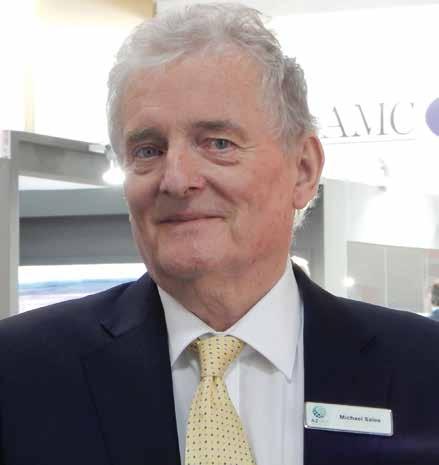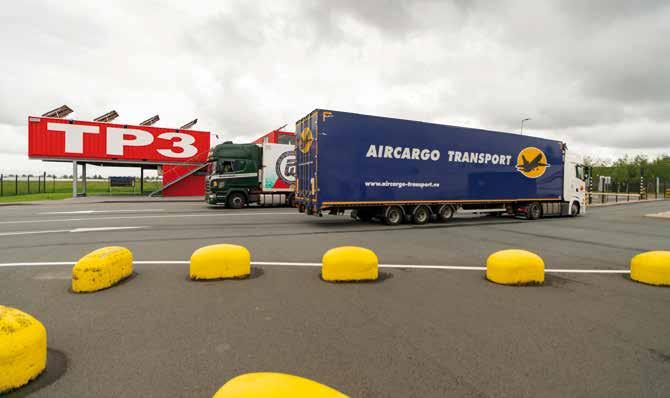
7 minute read
Innovation in air cargo
by Cargomedia
In the world of logistics innovation, we are working hard on subjects such as big data, blockchain and artificial intelligence. Our ambition is to not only undertake advanced research but to make this new knowledge available to companies. Nowhere does this come together as well as in air cargo.
Text Albert Veenstra
Advertisement
Let’s take a step back. During a recent conversation with a colleague professor we came to discuss the practical use of data. In a project about the use of sensor data for the transport of chilled consignments, they encountered the problem that you have so much real-time data from sensors (“hurray, data”, the researchers cry), but the crucial information required to interpret this data – namely the state of the consignment at the time of delivery – is often either not there or it has been saved into a totally different system. Upon arrival, if the consignment is okay, all real-time sensor data is immediately discarded. Only when the consignment, at the moment of delivery, is not okay, then the sensor data is dug out to, retrospectively, see where it went wrong.
The morale of the story is: these days we have so much data but we are not yet using it effectively, let alone using real-time data to steer a consignment as it is being transported in order to avoid it being spoiled. Interesting
Albert Veenstra

steps are being taken in a number of the projects we are financing in the air cargo world. I will discuss briefly the results of the DARA and LARA projects which are about, amongst other things, the choice of route and air cargo incident reports and focusing on refrigerated consignments such as medicines and vaccines. In DARA and LARA, the CWI (National Research Institute for Mathematics and Computer Science), VU Amsterdam, Eindhoven University of Technology, DSV Panalpina, KLM Cargo and, air cargo data analytic service provider Validaide, work together.
DARA
The DARA project concentrates on the issue that air freight forwarders can often choose from various options to send consignments by aircraft and they can find it difficult to weigh up how to deal with the balance between costs, transfer times, the duration of the transport, packaging and the risk of damage and temperature fluctuations. A tool for this has been developed within DARA based, among other things, upon research into historical data from sensors. From this data it is possible to analyse how various risks develop over time and how this can play a role in the choice of a specific routing for a consignment. With this tool and data analysis, forwarders can comply far more easily with the European rules for the transport of medicines (EU GDP) in which an assessment of transport risks plays a central role. Fairly advanced machine learning models were created in the background for this tool so that for a selection of routes the risks could be charted and ranked. The uncertainty experts experience in assessing particular risks had also been taken into consideration in this. A scientific study has shown how this methodology can work for the air cargo transport of pharmaceutical products. In the meantime, this model has been refashioned into a commercial product that is now being used by several forwarders worldwide, for example, supporting transport choices for the distribution of COVID-19 vaccines.
Eelco de Jong, Managing Director of Validaide: “The collaboration with TU Eindhoven and VU Amsterdam is extremely valuable to Validaide for the development of the Validaide platform. Our application is now being used by major international forwarders as a digital solution for the evaluation of transport risks for pharmaceutical consignments. As a consequence, these companies can work more efficiently, can make better assessments and more simply comply with European regulations (EU GDP). Essential for this is a standardised manner in which logistical service providers describe their capacity in Validaide and share this with each other. In the coming period we shall be building further upon this in the LARA project, for example, with further research into optimising packaging choices for refrigerated pharmaceutical consignments.”
LARA
Bernard Zweers’ dissertation research, incorporated in the LARA project, built upon the analysis of routes in complex networks for special consignments. He considered typical air cargo problems such as the risk of an aircraft being overbooked resulting in a consignment not being carried and thus having to wait for the next flight. Alongside a new model balancing the reliability of arrival and costs, Zweers also worked on a solution methodology in order that this model could very quickly recalculate. Choosing a route does not sound complicated but, if you want to model this, the complexity rapidly increases. The optimisation of a routing choice using even a small realistic network,

can take several hours. Obviously, in practice, this is not desirable. With Zweers’ calculation methodology relatively difficult routing problems can be solved in a few seconds.
An important ingredient missing from the better utilisation of data is having a complete and shared picture of what is happening in a particular sector. For instance, how do you describe a ‘consignment’, a ‘flight’, an ‘incident’ or a handling agent’s capacity? For this you must develop an integral, so-called, ontology for air cargo logistics. In such an ontology a link is laid between operational processes and an abstract description of these with the help of variables and parameters. The latter can then be ‘filled’ with data from, for instance, sensors, IT systems, human observations and reports. If that has happened, computers and algorithms can help to solve complex planning questions, assist with problems of choice, undertake compliance checks and prepare forecasts. In the LARA project a number of people have been working on such an ontology. A part of this ontology is also incorporated into the Validaide tool, notably to describe capacities for the transport and storage of special consignments. More than 500 logistics companies are now using this tool to define capacities, including major handling agents such as Swissport and WFS. This information forms an important source for the aforementioned route assessments that forwarders have to make.
Another interesting part of the LARA project is the analysis of cargo incidents. In air cargo every consignment has something special. Problems with consignments are recorded in socalled incident reports. The problem with these reports is that in compiling them there is a huge amount of freedom for the naming of problems and the reasons for them. Language and terminology are also often not uniform. Due to a lack of standardisation and formal coding of input it is barely possible to undertake good research of any scale on incidents. In the LARA project a path has therefore been started by means of, once again, machine learning methods, to automatically read the reports and standardise content. The technique used is called natural language processing, NLP. This leads to a clear classification of incidents, as well as the nomination of standard factors that could be an explanation for the incident. Quantitative research can then be undertaken using this structured data that could lead to the identification of possible or probable causes. This can be as simple as the route, or an airport where ‘things often go wrong’ or a more complex combination of circumstances. The aim of this sort of modelling is, of course, not only for retrospective explanations, but also in order to be able to forecast in advance what risks there may be for particular incidents. Such a benchmark can then, once again, be appended to a routing choice tool such as the one being developed in DARA.
In the coming period TU Eindhoven and VU Amsterdam will undertake further research for the LARA project on the analysis of historical weather data. This research is focused mainly on the optimisation of packaging choices for refrigerated pharmaceutical consignments. There is a huge range of possible packaging for these products with significant variations in cost, weight and thermal properties. By coupling earlier study results with detailed weather data from the past 30 years the researchers hope to be able to make better assessments between, for instance, transport costs, CO2 emissions and the risks of temperature variations.
I began this article with the observation that sometimes we can have a lot of data but (can) do little with it. In the DARA and LARA projects the project partners have shown that this should not discourage you. In these projects important steps have been taken to ensure better data (for example, from an incident report), to be able to better understand the data (with the help of an ontology) and swiftly calculate answers to complex questions such as routing choices. Many of these complicated solutions land in a practical tool available to the air cargo world via innovators such as the company Validaide.
Albert Veenstra is Professor Trade and Logistics at the Rotterdam School of Management, Erasmus University Rotterdam, and Scientific Director of TKI Dinalog










